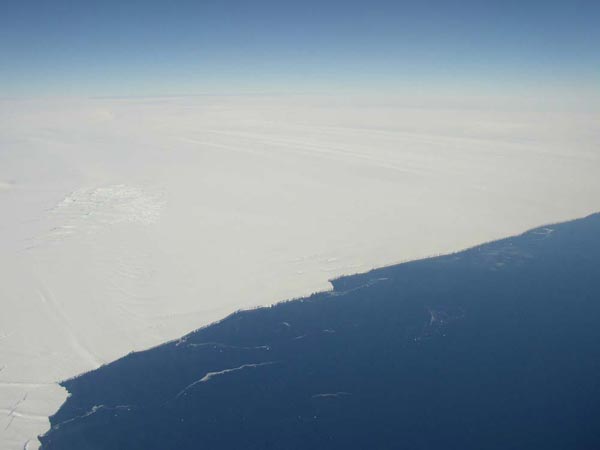
Reason Antarctic Glacier Is Melting Faster Is Found

One of the more daunting future effects of climate change involves the rise in sea levels that is expected to occur as warming causes the ocean's waters to expand and glaciers to melt, pouring more water into the seas.
A key unknown potential contributor to that glacial melt is the thinning ice of West Antarctica, which is covered in a chunk of ice about the size of Greenland — enough water is held in that ice to raise sea levels by several meters. Scientists estimate that West Antarctica is currently contributing nearly 10 percent of global sea level rise from an acceleration in glacier ice melt.
Pine Island Glacier in particular has been identified as a major source of West Antarctica glacier melt. With the help of a robotic underwater vehicle, scientists have now figured out what is causing Pine Island Glacier to melt so fast.
Seafloor ridge
Pine Island Glacier, like all outlet glaciers, has a portion that sits on land, and a portion that floats on top of the sea — the line between the two portions is called the ground line. It is the land portion of the ice that contributes to sea level rise.
One process by which glaciers run ice out to sea is by calving of icebergs. A large chunk of Pine Island Glacier fell off in 2007.
Scientists sent a vehicle called Autosub to dive deep below the glacier's floating ice shelf to see what might be speeding up its melt. The sub found two things: warm water below the glacier and a 980-foot (300-meter) tall ridge on the ocean floor that no one knew was there.
Sign up for the Live Science daily newsletter now
Get the world’s most fascinating discoveries delivered straight to your inbox.
{{adsense|premier|left}}
Pine Island Glacier once sat on top of the ridge, which slowed the flow of the glacial ice into the sea. In recent decades, though, the glacier thinned and disconnected from the ridge, which allowed the ice to flow more rapidly from land to sea.
The separation from the ridge also let in warmer water "from deep down in the water masses that circulate around Antarctica [that] hasn't been in contact with the ocean surface for a long time," said Christian Schoof of the University of British Columbia in Canada, who was not a part of the team that studied the glacier.
The warm waters can flood over the ridge and into a widening cavity that now extends to an area of about 390 square miles (1,000 square kilometers) under the ice shelf. Those warm waters are causing the bottom of the ice shelf to melt, resulting in continuous thinning and acceleration of the glacier, which could cause more of the ice that is currently on land to melt into the sea and contribute more to sea level rise.
Connection to climate change?
What caused the initial separation of the glacier from the ridge is uncertain.
"We do not know what kick-started the initial retreat from the ridge, but we do know that it started some time prior to 1970," said study leader Adrian Jenkins of the British Antarctic Survey.
Researchers only began to closely study Pine Island Glacier in the 1990s, so there are no direct observations of the glacier before and during its separation from the ridge. To learn more about that process, scientists will need to use ice cores (long cylinders of ice drilled from glaciers that show the successive layers of ice that formed over the years) and computer modeling to figure exactly what happened, Jenkins said.
Learning more about that process "is vital for evaluating the risk of the potential widespread collapse of West Antarctic glaciers," he said.
The case of Pine Island Glacier does present cause for concern, the scientists say.
"Since our first measurements in the Amundsen Sea, estimates of Antarctica's recent contributions to sea level rise have changed from near-zero to significant and increasing," said study team member Stan Jacobs of Columbia University's Lamont-Doherty Earth Observatory in New York. "Now finding that the [Pine Island Glacier]'s grounding line has recently retreated more than 30 km [19 miles] from a shallow ridge into deeper water, where it is pursued by a warming ocean, only adds to our concern that this region is indeed the 'weak underbelly' of the West Antarctic Ice Sheet."
The study of Pine Island Glacier was detailed in the June 20 early issue of the journal Nature Geoscience.
- North vs. South Poles: 10 Wild Differences
- Antarctic Sea Ice Paradoxically Growing
- Images: Ice of the Antarctic
This article was provided by OurAmazingPlanet, a sister site to LiveScience.

Andrea Thompson is an associate editor at Scientific American, where she covers sustainability, energy and the environment. Prior to that, she was a senior writer covering climate science at Climate Central and a reporter and editor at Live Science, where she primarily covered Earth science and the environment. She holds a graduate degree in science health and environmental reporting from New York University, as well as a bachelor of science and and masters of science in atmospheric chemistry from the Georgia Institute of Technology.










